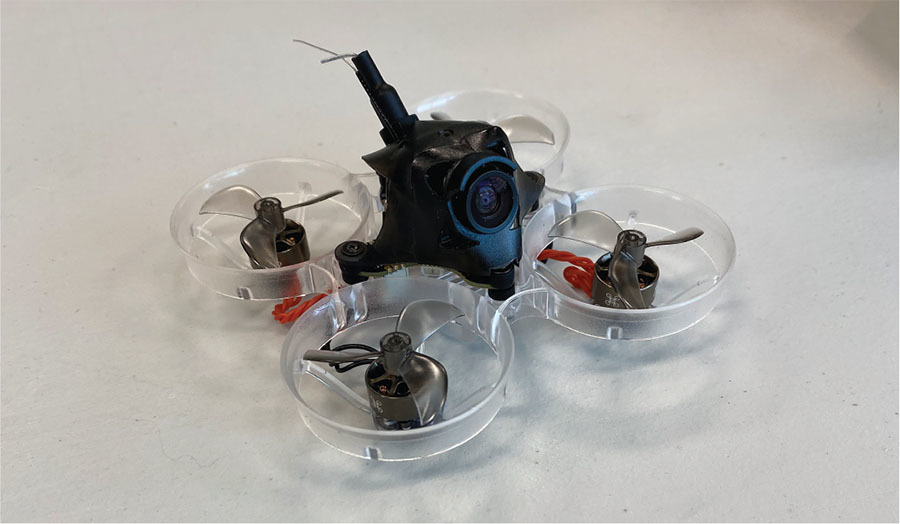A ready-to-fly drone that’s perfect for beginners! By Gwen Mathis | [email protected] Photos by the author As seen in the September 2023 issue of Model Aviation.
Image

Image
 At a Glance
At a Glance
Image

Image
- Drone size: 65mm
- Weight: 24 grams (without battery)
- Camera: Mark 3 with 25mw VTX
- Motors: Four 0802 19,000 Kv double ball-bearing brushless
- Propellers: Four Azi Tri-Blade 31mm
- Receiver: Built-in SPI ExpressLRS
- Battery Input: 1S
- Frame: Cockroach65 Brushless Frame
- Canopy: Goober Canopy v1
- Price: $94.99
Image
- Pretuned and ready to fly when it leaves the box.
- Great for new fliers.
- Reliable and durable.
- Good for indoor flight.
Image
- Short flight time.
Image
Build and Materials
The HummingBird comes fully built in a convenient, little package. When you open the box and look at the drone, you’ll notice how durable and sleek it is. It is equipped with a Mark 3 camera, four 0802 19,000 Kv double ball-bearing brushless motors, four Azi Tri-Blade propellers, the radio and camera antennae, and an all-in-one (AIO) board with F411 and built-in ELRS SPI. All of these components are kept safe by the drone’s Goober canopy and Cockroach frame. The HummingBird’s Goober canopy keeps the camera and AIO flight controller safe from collisions and drops, holds the drone’s radio and camera antennae in place, and protects the Mark 3 camera against tough impacts, thanks to its neck collar. The Cockroach frame is lightweight, versatile, and durable, protecting the drone while still looking sleek and stylish. The frame houses the motors and propellers, and it has a small shelf that stores the drone’s battery during flight.Image

Image

Flying
Although some of the other Tiny Whoops I’ve flown from NewBeeDrone have been optimized for freestyle or general flying, the HummingBird is optimized for racing. Thanks to its motors, it has great control of its torque. The HummingBird can handle yawing, pitching, and rolling well. I found that I was able to make turns around corners with the HummingBird easier than anticipated. It was not hard to handle or overly powerful while traveling in a straight line. I flew this drone in both line-of-sight (LOS) and FPV. My experience with LOS flight started out bumpy, but thanks to the stability of the HummingBird, I was quickly able to gain a good sense of control over the drone. I went from flying the drone immediately into the ceiling to carefully weaving it under and over the conference room tables at AMA Headquarters in Muncie, Indiana. I eventually grew familiar enough with flying LOS and connected the HummingBird to NewBeeDrone’s FPV goggles (not included with the purchase of the HummingBird). After I began flying FPV, I only grew more comfortable with the process. From time to time, the camera feed would glitch for a moment, but overall, I was able to clearly see where I had piloted the drone and could find my way back to the imaginary course that I had created in the conference room. I eventually felt relaxed enough to let others watch my newly acquired flying skills and fly the drone in close proximity to people, as long as we were all mindful of where it was. I even grew comfortable enough to attempt to fly it outside at the park on a particularly warm day in March, but I do caution you to check how strong the wind is. Even the slightest breeze can push the lightweight HummingBird away from you.Image

Final Thoughts
Overall, I had a positive experience with the HummingBird. As I mentioned (many times) earlier, I am a beginner flier and modeler. For those of you who have been flying for years, it might be easy to forget the beginning of your model aviation adventure. Experienced pilots might be laughing (understandably) at my clumsy description of the HummingBird and the tellings of my flying horror stories. I hope that, in a few years when I can casually fly a more advanced drone or model airplane, I will look back on this column and appreciate how far I have come. It is important to remember that everyone has to start somewhere, and when you start at the beginning, you can only improve. If you are an advanced or experienced pilot, I encourage you to look back on your own journey and reflect on what made you the modeler you are today. As a community, it is important that we have admiration for all modelers—beginner, intermediate, and advanced. Careful introspection can help you to strengthen your respect for your fellow hobbyists. Thank you for reading, and I wish you all nothing but clear skies and safe flights.
SOURCES:
BETAFPV
[email protected]
https://betafpv.com










Comments
Add new comment